Water plants can make an ordinary pond look extraordinary. Whether you desire some specimens to grow from the depths or float serenely across the water, our new pond plant selection at Rainbow Gardens Bandera location has got them. Maybe you are just looking for some species to border the edges of your ponds; they’ve got those too. Mid spring to early summer is the best time to plant water plants in your pond as the water is warming up and plants are able to establish well at this time.
Water plants can help provide shade and protection from predators for any fish in your pond, and can help to slow the growth of algae. Now is the perfect time to replace, replenish, or try water plants in your ponds. Let’s take a look at some of our highlights.
Se our latest arrivals (2025) of water plants at each of our locations below.
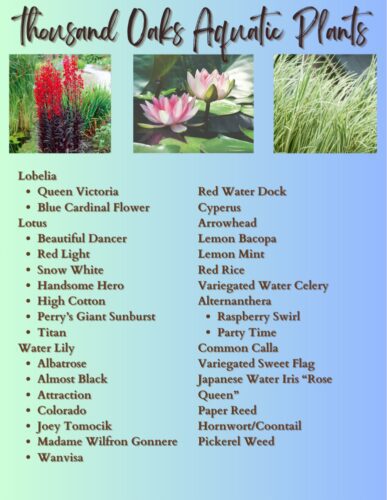
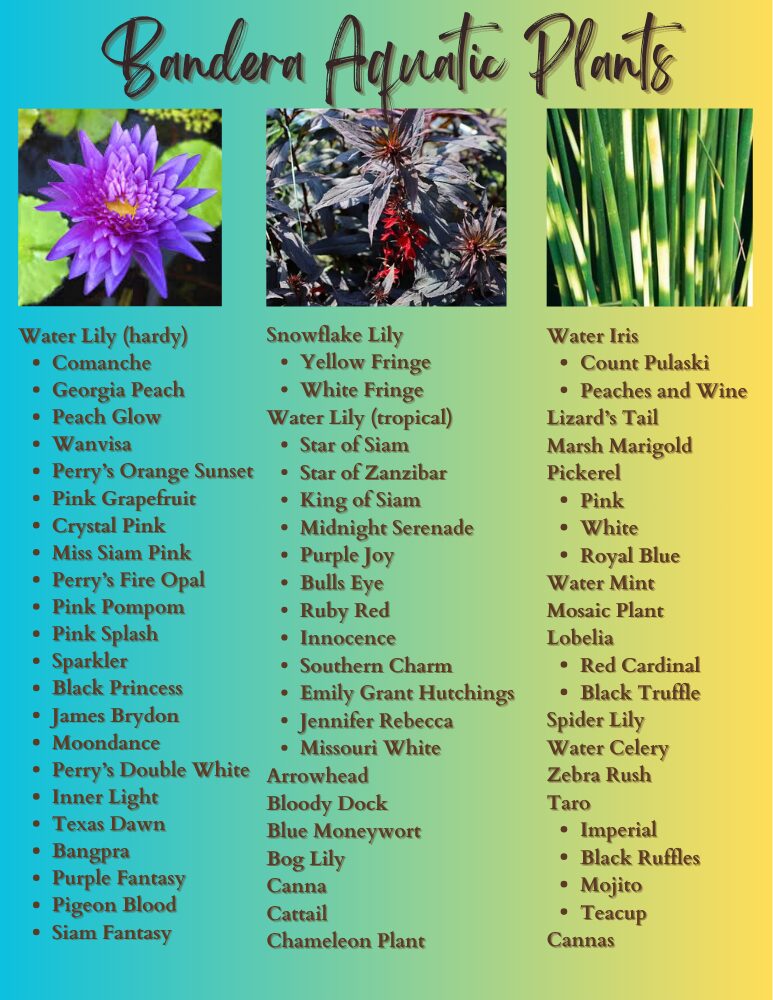
4 Favorite Water Plants for San Antonio Ponds
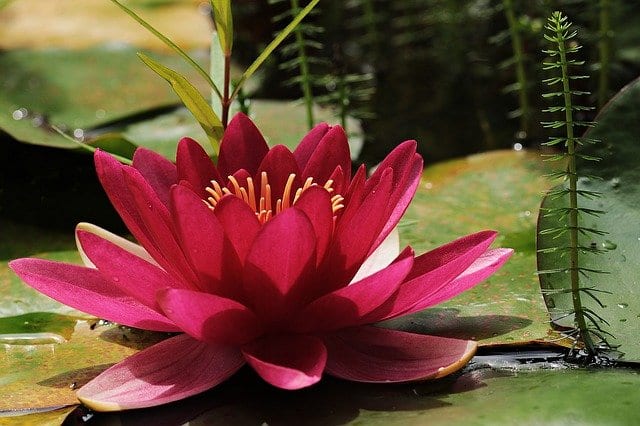
Hardy and Tropical Water Lilies: These are some of our favorite water plants for ponds. From the whimsical lily pads you can imagine a frog sunbathing on, to the vibrant, intricate flowers that bloom and effortlessly float along the water, these lilies provide quick beauty to your ponds.
Differences between the two types of water lilies include color, size, and bloom abundance, but the main difference between hardy and tropical water lilies is cold tolerance. Hardy water lilies bloom early summer to early fall and go dormant through winter and pop back the following year. Tropical lilies bloom late spring through fall and will generally not survive winter temperatures. However, you can overwinter your tropical lilies so you can enjoy them again when warm weather returns.
Tropical lilies (pictured in title photo), generally produce more blooms and bigger blooms than hardy lilies and include night-blooming varieties in their category, which is great for those who enjoy their ponds in the evening hours. Hardy lilies (pictured above) still offer brilliantly-hued blooms with the bonus of a “set it and forget it” ease of care. (Although, you should divide and repot every 2-3 years as your lilies will get crowded.
See this link for some great planting tips for different types of water plants.
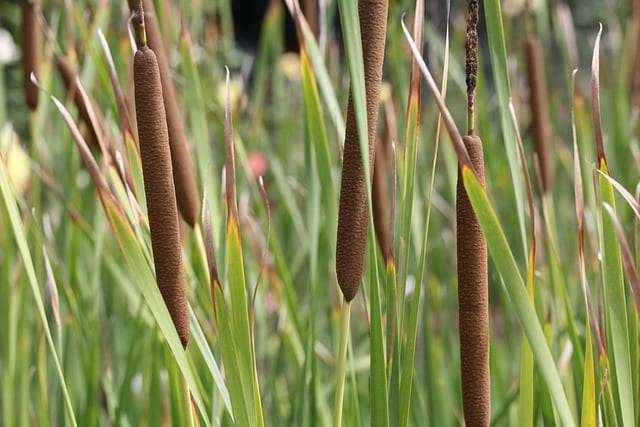
Cattail water plants have always been a favorite of mine. Looking like a Texas State Fair offering (Cornydogs, anyone?), the female flowers of cattails comprise the brown, cylindrical spike at the terminal end. These water plants are very commonly found around the borders of ponds and marsh areas. Check out this link for a super fun video of the great cattail fluff phenomenon and you’ll see why this water plant gives the Happy Gardener happy memories indeed. (Disclaimer: While there are parts of the cattail plant that are edible throughout the year, I don’t recommend putting the fluff in your mouth. Phth, phth, if you know what I mean.)
They grow rapidly to heights of about 5 to 6 ft. and can spread rapidly as well. (You can plant them in pots to control the spread of rhizomes if desired, and divide each spring for more plants!). The dense cattail thickets along borders of ponds make excellent, protected areas for fish and frogs to lay their eggs. Red-winged blackbirds use them as a favored habitat.
Cattails are winter hardy in our planting zone in San Antonio. See more about cattails by accessing the link at one of our favorite resources for plants in Texas, the Lady Bird Johnson Wildflower Center.
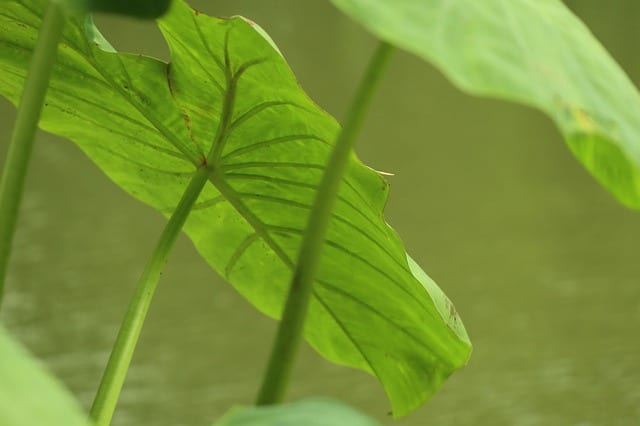
Water Taro probably looks pretty familiar to you. These water plants are in the same family as the elephant ears that grace our shade gardens. These large-leaved foliage plants are perfect for those watery edges of your pond that are shielded by trees from the hot afternoon sun. Partial sunlit or dappled sunlit areas are ideal.
These tropical water plants will go dormant over mild winters and return in spring, much like the elephant ears in your gardens. Old foliage can be cut back in late winter/early spring and new growth will emerge as the weather warms up. In cases of colder temperatures, water taro tubers can be dug up and stored in a cool, dry place for the winter. Water taro seem to add an instant exotic, tropical feel to your ponds. Look for some fun varieties of these water plants like ‘Bikini Tini’ and ‘Mojito’ at our Bander location.
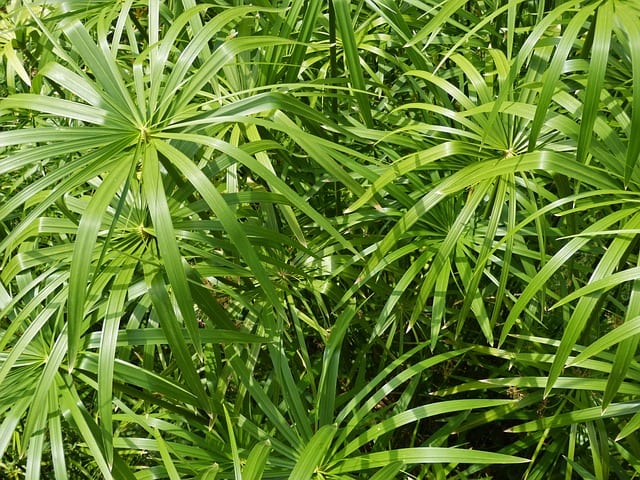
Papyrus, also called Umbrella plant, is a water plant that adds texture, height and dimension to boggy areas, pond edges and also looks great in containers around pool areas. Unlike many water plants, papyrus is very tolerant of shade and can live happily in both partial to full shade areas around your pond. Papyrus is hardy in zones 9-11, so depending on exactly where you live in San Antonio, and depending on our winter temperatures, you might consider treating this water plant as an annual. (Temps colder than 35° F are generally destructive)
Papyrus comes in multiple varieties making it a great option for folks needing a smaller statured water plant like the Dwarf papyrus (2-3 ft. tall), or a stunning taller specimen like the Giant Egyptian papyrus (6-8 ft. tall) with other options inbetween.
Look at this water plant at maturity and you can see how the pendulous foliage, which creates a wild pompom-like topping on the plant, helped give papyrus the nickname ‘umbrella plant’. Give your ponds an exotic feel by planting a few of these specimens around its watery edge.
These are just a few of our favorite water plants that have recently been brought in to our Bandera location. You can also trip upon: aquatic mint, Parrot Feather, water poppies, bog lilies, pickerel, and more. Invite some water plant friends to your pond and create an enchanting oasis to rest and recharge your mind, body, and soul. Nature does wonders.
~The Happy Gardener, Lisa Mulroy


Do y’all sell Water Lettuce?
Hi Bernice,
I do not see any water lettuce on this recent shipment order. Hopefully it is something we can consider carrying when available in the future.
Are these the only pond plants you have?
Hi Bill,
No, these are just a few that I highlighted. Did you have a specific type of pond plant you are looking for?
looking for pond plants
pond has koi and a turle
Both of our locations recently got in a new shipment of pond and marignal water plants. Come take a look!